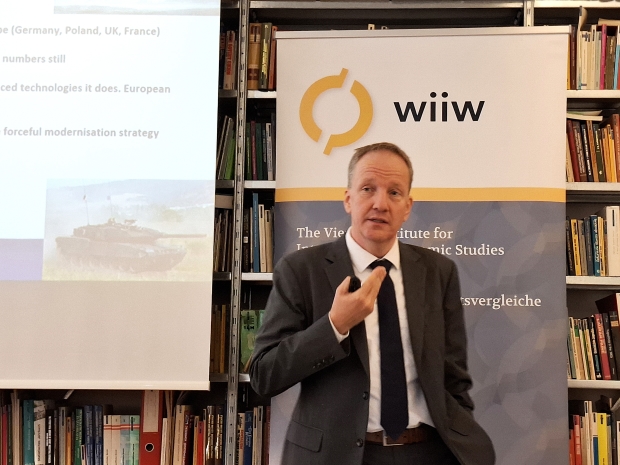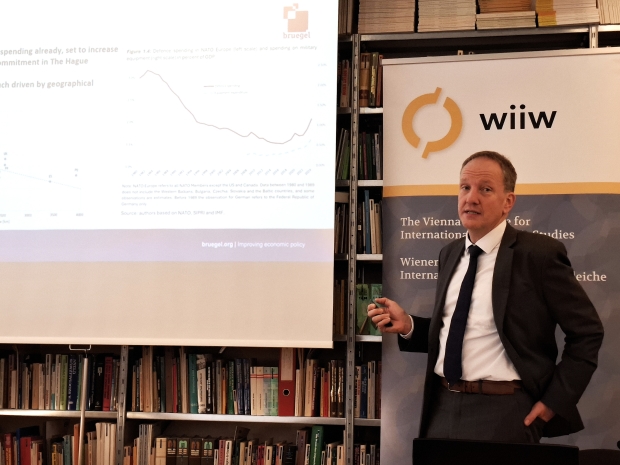Lecture by Guntram Wolff: Can the EU be fit for war by 2030?
16 October 2025
Without a collaborative approach towards defence and military procurement, the EU risks losing its standing and credibility vis-à-vis Russia while deepening its dependency on the US
image credit: wiiw/Andreas Knapp
Can the EU be fit for war with Russia by 2030? Following the principle of ‘hope for the best, prepare for the worst’, the EU must make its rearmament credible, effective and affordable. This was the key message delivered by Guntram Wolff, Senior Fellow at Bruegel and Professor of Economics at the Université libre de Bruxelles (ULB), during a lecture at the Vienna Institute for International Economic Studies (wiiw) on 8 October. The lecture compared EU and Russian military capabilities and analysed the prospects for European rearmament.

image credit: wiiw/Andreas Knapp
According to Wolff, to properly rearm itself, the EU should ideally build a common defence market to boost competition, have a joint procurement strategy for more market power, and work towards collective ownership and procurement of certain ‘strategic enablers’ – entailing a range of weapons systems and capabilities (e.g. drones, combat aircraft and satellites) – to spread the fiscal burden.
Most EU countries – with the exceptions of Austria, Cyprus, Ireland and Malta – are members of NATO and have already considerably ramped up defence spending as part of their obligations within the alliance, particularly since 2023. Countries geographically closer to Russia are showing a greater willingness to spend a larger share of their GDP on defence. Additionally, Germany dominated EU procurement in 2024 and the reform of the German debt brake may be a step in the right direction.
However, the EU procurement market remains very fragmented, which poses a major hurdle in the current landscape. How can the EU efficiently acquire the equipment it needs? At present, there is not a lot of cross-European initiative, with most EU countries buying nationally while heavily relying on the US for certain crucial equipment, such as combat aircraft, electronic surveillance systems, strategic airlift capabilities, long-range artillery, satellites and AI-integrated systems. To add to the challenge, the EU finds itself trailing in the race to develop and produce military satellites for reconnaissance, navigation, command and control, etc. Wolff pointed out that the EU needs to invest more in areas like R&D to stay competitive and maintain a credible standing vis-à-vis Russia.

image credit: wiiw/Andreas Knapp
By contrast, Russia’s authoritarian regime has proven particularly efficient at centralising resources to modernise and adapt quickly. While it is hard to evaluate Russia’s stocks of operational tanks due to the high rate of attrition in Ukraine, Wolff stressed that Russian military production has become more robust across multiple fields, including very modern ones like hypersonic missiles and drones (areas where the EU is lagging). He also drew attention to Germany’s decline in capabilities, the UK’s big gaps in air defence, and the fact that, despite the significant build-up of its land forces, Poland is still no match for Russia.
Moreover, Wolff explained that most economic analyses tend to focus primarily on the size of a country’s GDP when evaluating its economic prosperity and military potential while overlooking purchasing power parity (PPP), which may provide a more accurate measure. Russia’s war economy and defence production are large and growing, as reflected in its military spending measured in PPP, which amounts to around USD 400 billion per year — roughly the same amount that EU countries spend in total.
Considering the arguments mentioned above, Wolff mentioned that the only way for the EU to maintain credibility is by adopting a more collaborative approach. A common defence market would increase competition and offer arms manufacturers far greater sales potential, thereby creating incentives to invest in expanding production. Joint procurement would also lower unit costs. There are already EU mechanisms in place to serve as models and build upon, such as the European Defence Agency (EDA) and the Permanent Structured Cooperation (PESCO).
Nevertheless, Wolff argued, these are still not enough to reduce a certain ‘defence nationalism’ in EU member states. In addition, limited budgetary capacities, certain EU provisions, and the challenge of how to include non-EU members (e.g. the UK) make implementing such policies even more complicated. Ultimately, the EU must find EU-based solutions. In conclusion, Wolff predicted that if the procurement market remains this fragmented and R&D spending does not increase significantly, dependency on the US will only grow, especially for cutting-edge, high-tech systems.
